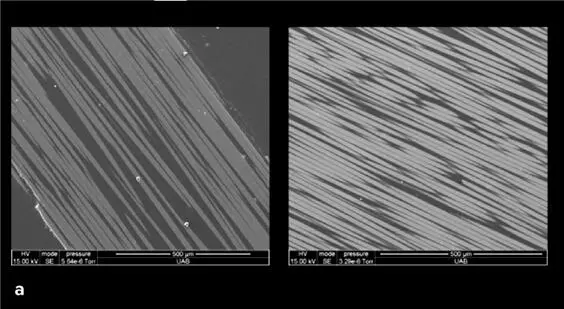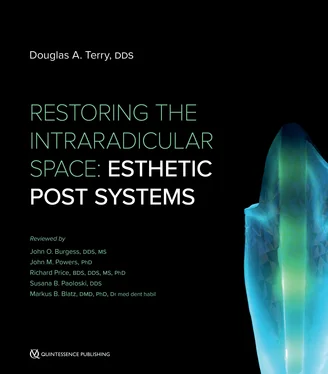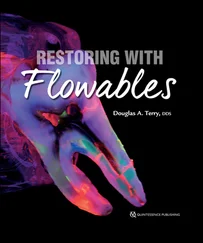1 ...7 8 9 11 12 13 ...18 An additional method, the direct/indirect anatomical formed fiber-reinforced post system that uses a pattern resin to replicate the anatomical configuration of the prepared post space, can be created in the laboratory or chairside using a silicone matrix to replicate the pattern with the injectable resin composite technique.456 One study indicated that anatomical posts relined with composite resulted in the highest fracture resistance in comparison to other methods.185 ,457
The direct fiber-reinforced resin post and core system includes the following components:
• Post material
• Adhesive bonding agent
• Luting agent
• Core buildup
• Extracoronal restoration
Post material
The first component of the fiber-reinforced post and core system is the post material, which uses either a bondable reinforcement fiber (eg, Ribbond-THM; Construct) or a prefabricated fiber-reinforced composite post (eg, D.T. Light-Post, Bisco; ParaPost Fiber White, Coltène/Whaledent; FRC Postec Plus, Ivoclar Vivadent; Rebilda Post, VOCO; GC Fiber Post, GC America; EndoSequence Fiber Post, Brasseler USA; iLumi Super Fiber Post, iLumi Sciences, Inc). The prefabricated fiber-reinforced post is classified according to its shape, surface configuration, 60 ,289 and material. The basic shape and configuration include tapered serrated, tapered smooth-sided, tapered threaded, parallel serrated, parallel smooth-sided, and parallel threaded. These posts consist of a resin matrix with reinforcing glass, quartz, or woven polyethylene fiber.210 ,458 ,459 The categories according to material include methacrylate and epoxy posts, posts reinforced by polyethylene fibers, posts reinforced with quartz or glass fibers, and posts reinforced with unidirectional carbon fibers. 42 ,202 ,444 The matrixes are usually epoxy or methacrylate polymers that bind the fibers together and encompass the fibers, forming a continuous phase around the reinforcement fibers. This phase transfers the forces to the fibers and protects the fibers from moisture.366 These reinforcement materials enhance the mechanical properties of the tooth-restorative complex by increasing flexural and tensile strengths.194 The mechanical properties are dependent on the type, orientation, and positioning of the reinforcement fibers.366 ,460 The orientation of these fibers can be unidirectional in which each fiber is parallel to the other or multidirectional in which the fibers are in two or more directions to each other. There is a direct relationship of concentration of fibers to tensile strength; the higher the concentration of fibers in the matrix, the greater the tensile strength of the composite post366 ( Fig 1-15).


Fig 1-15 (a and b) Scanning electron micrographs of the light-transmitting fibers of various fiber-reinforced post and core systems: D.T. Light-Post (top) and iLumi post (bottom) in transverse section (a) and cross section (b) . (Courtesy of John O. Burgess, DDS, MS.)
The benefits of the glass and quartz fibers include superior compression and impact properties, high tensile strength, low extensibility, and resistance to solubility, corrosion, and biochemical degradation202 ,461; in addition; they are relatively inexpensive, and their transparent characteristic provides the necessary esthetic requirement. The glass and quartz fiber posts exhibit the most favorable optical properties for reproducing the natural characteristics of the restored endodontically treated tooth. 42 ,173 With the fiber-post luted systems, the reflection, absorption, and transmission of the light is dependent on several factors that include the size and concentration of the filler, the pigment color, and the fiber post composition.200 ,236 However, the radiopacity of the fiber posts varies, and this characteristic is important to determine the position and length of the post in the post channel during standard radiographic procedures.200 Thus, it is important to understand that all fiber-reinforced posts do not have the same mechanical characteristics. The quality of the fiber-reinforced post depends upon a multitude of factors, which include the morphology of the fiber, the type of fiber and matrix, concentration of fibers, direction of the fibers, pre-tensioning of the fibers, proper impregnation of fibers, polymerization shrinkage of the resin, interfacial adhesion, and the manufacturing process.346 ,366 ,462 ,463 Studies indicate that voids and microcracks can occur during the manufacturing process that can contribute to inferior mechanical properties of fiber-reinforced posts. 17 ,459 ,464 ,465 Thus, a proper selection based upon scientific studies is required to prevent mechanical failures.346 ,459 ,464 ,465
Adhesive bonding agent
The second component of the system is an adhesive bonding agent that reduces the undesirable contraction gap at the dentin-resin interface produced during polymerization of the resin cement. This gap may create microleakage and bacterial infiltration at the coronal end of the root. 55Achieving a reliable and durable bond at the root dentin-adhesive interface is critical to the long-term success of the system. 107 ,466 –468 There are many variables that affect achieving an optimal bond in the post channel, such as the post channel preparation, configuration factor (C-factor), depth of light penetration, post channel irrigation, anatomical and morphologic characteristics of the radicular dentin, structural differences in radicular dentin, the incompatibilities of different adhesive systems with resin cements, and the competence of the operator. 100 ,148 ,202 ,346 ,467 ,469 –473 Because of these unfavorable conditions in the intraradicular space and the smear layer developed, the etch-and-rinse strategy with phosphoric acid may dissolve the dense smear layer inside the post channel more effectively. 100 ,202 ,468 ,474 However, this strategy requires multiple steps in a difficult environment to achieve an effective bond, whereas the self-etch strategy is a simplified technique with a limited access to the post space that may be more user-friendly and less technique sensitive. 100 ,202 ,468 ,474 As aforementioned, there are various methods and materials to improve resin impregnation into radicular dentin (see chapter 2 as well as the later section entitled “Maximum post retention and core stability”). However, effective bonding to radicular dentin requires a strict protocol with accuracy and attention to detail.475 ,476
Luting cement
The third component is the luting cement. Cementation of posts with adhesive luting cements provide greater retention,149 ,212 reduced microleakage,468 and an increased resistance to root fracture.477 ,478 A myriad of techniques and materials have been utilized to cement fiber posts to radicular dentin.479
Although glass ionomers and resin-modified glass ionomers adhere to root dentin by chemical and micromechanical retention479 ,480 and can be used successfully for cementation of fiber posts, it has been well documented that fiber-reinforced composite posts should be luted with an adhesive resin material. 52 ,346 ,479 ,481 These adhesive materials include the conventional resin cements that are associated with etch-and-rinse and self-etch adhesive systems as well as the self-adhesive resin cements that do not require a prior application of bonding agents. These materials are categorized according to their polymerization mechanism as self-cured (chemical polymerizing), light-cured, or dual-cured.482 –484 The factors associated with the technique sensitivity of adhesive luting the fiber post to radicular dentin in the post channel include restricted access, limited placement ability, achieving adequate moisture control, the density and structure of dentinal tubules at the apical region of the root, surface treatment of the dentin, evaporation of the solvents from the adhesives, unfavorable cavity configuration within the post channel, insertion of luting cement without air entrapment, sufficient polymerization of the cement,200 ,472 ,473 ,485 and incompatibility of adhesive systems.
Читать дальше














